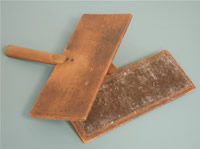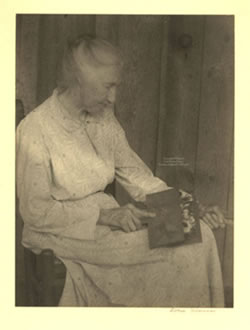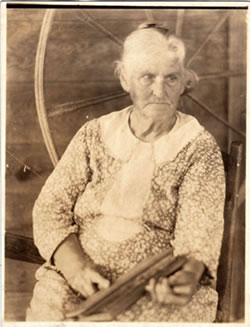Textiles:
Carding

A craftsman today would begin the weaving process by purchasing yarn, but during the Craft Revival, artisans initiated the process by growing and preparing their raw materials. This meant raising sheep and growing cotton or flax. Wool, sheared from sheep, was both soft and warm. But before actual weaving could begin, wool had to be washed, spun, dyed, and warped. Flax - a plant grown in summer and harvested in the fall - was retted in winter, a process of wetting and separating plant fiber from unusable parts of the plant.
Before thread could be spun, wool had to be picked clean of sticks and burrs. The wool was then combed smooth in a process called carding. Used in pairs, cards are two wooden paddles with metal teeth. Wool was repeatedly combed from one card to the other, aligning the fibers into soft, smooth strands while, at the same time, strengthening them. During the revival, some larger production centers used wool carded at industrial woolen mills, but most in-home production was begun with hand-carded wool in this way.
In Appalachian weaving, flax and wool were often used together to create the popular linsey-woolsey coverlet. Coverlets made of linsey-woolsey were favored during the Craft Revival because they were both durable and warm. Durability came from flax spun into linen, while their warmth came from sheep’s wool.
Sarah Sanoma Hatchett (dates unknown) was a spinner known locally as “Granny” Hatchett. She lived in the Bellview community of Cherokee County, North Carolina. Photographer Doris Ulmann made this portrait of Hatchett in 1933, when she visited the John C. Campbell Folk School. Hatchett holds a pair of cards in her hands.
See More: Carding Combs/Paddles





